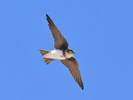search
classification
|
basic information
|
video
|
reports |
Sand Martin
Riparia riparia (Linnaeus, 1758)

|

|
|
|
2021-04-26
Dolon, Issyk-Kul region |
© Irina Romanovskaia
|
|
Description
The Sand Martin is less than Sparrow on size. Upperparts are dark-brownish, upperparts are white with brown band on the breast. The tail cut isn't deep. The bill is black, the legs brown. On the legs there are rare feathers. From afar it is possible to mix up it with House Swallow; it is distinguished from House Swallow by the dark rump and dark breast band. Both sexes are similar; no seasonal differences of plumage. Juveniles are similar on adults but have on the uppaerparts the scaly parent formed by the buffy tips of the feathers. Weight 11-16 g, long 12-14, wing 9,7-11,5, wingspan 28-30 cm.
Biology
The Sand Martin is abundant breeding migrant. It inhabits the rivers, ponds and lakeside banks; low dry banks or sand pits; sometimes far from water. Nesting occurs on plains in sand or clay banks, clay walls of houses, wells and careers with vertical walls. It appears in flocks of 20-50 birds in early to mid April in southern areas, and in mid April to early May in northern ones. At Chokpak Pass most birds migrate late April to first half of May, last spring migrants recorded late May. Most often it breeds in colonies of some tens or hundreds pairs, but sometimes colonies formed by the several thousands pairs, and the nest burrows dispose on only 20-50 cm one from another. Nest hole is excavated by both male and female, the nesting chamber is lined with dry grass and feathers over the 3-7 day period. Clutches of 3-5 eggs appear late May to early July. Both parents incubate 12-16 days and feed juveniles, fledged at about three weeks old, from end of June to mid – to end July. Some pairs bring up two broods, repeated breeding after the loosing of first clutch is common, as some colonies are destroyed by strong waves. It eats only insects, catches them in air, more often at the water or over the water. But can peek up insects from the water, from the plants and the ground both catching them on flight and sitting down. At cold snaps and incessant rains when the insects not fly, the Swallows sit out in holes, gather in groups, cuddle to each other, lapse to catalepsy with decreasing of the body temperature. In the first days after fledging the juveniles keep at a colony and often come back to the holes. Later they join in flocks and wander along the rivers; have a rest on wires; stay on the night in the nearby colonies or in reeds. Autumn migration begins in mid August. Most birds leave late August to first half of September, often in mixed flocks with Pale Sand Martin, Barn Swallow, Red-rumped Swallow and European House Martin. Latest migrants recorded in late September to late October.
References
Gavrilov E. I., Gavrilov A. E. "The Birds of Kazakhstan". Almaty, 2005.
В.К.Рябицев. "Птицы Урала, Приуралья и Западной Сибири". Екатеринбург, Изд-во Уральского университета, 2000.
Э.И.Гаврилов. "Фауна и распространение птиц Казахстана". Алматы, 1999.














